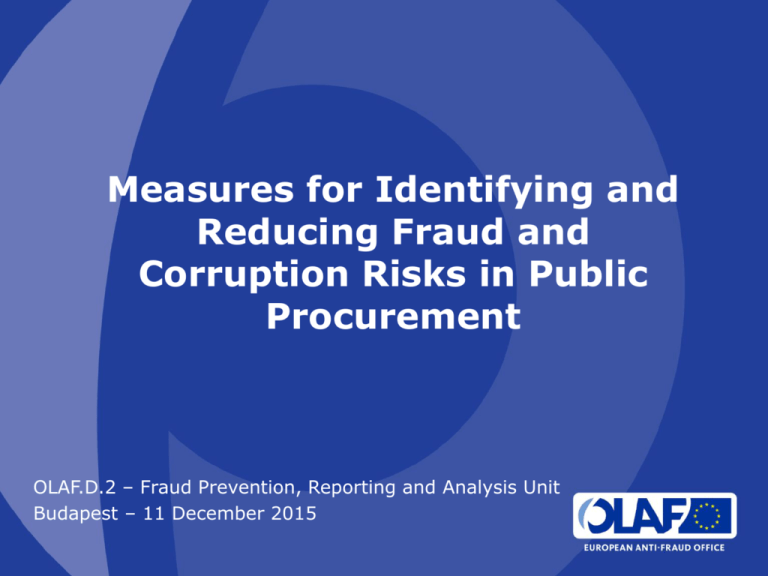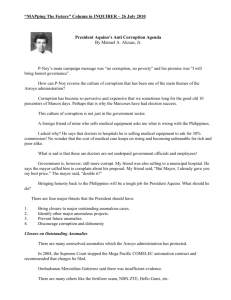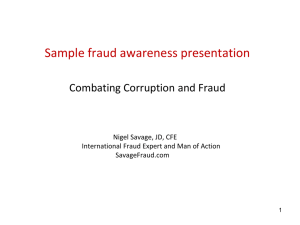Fraud prevention tools – Red flags
advertisement

Measures for Identifying and Reducing Fraud and Corruption Risks in Public Procurement OLAF.D.2 – Fraud Prevention, Reporting and Analysis Unit Budapest – 11 December 2015 Costs of corruption Public procurement = about 20% GDP in the EU (2010: € 2.4 trillion) Scope of the study: 8 Member States and 5 sectors Direct cost of corruption <2.9% , 4.4%> value of procurement published in OJ OR Between EUR 1 470 million and EUR 2 247 million 2 Costs of corruption Clean projects 5% loss Corrupt/grey projects 18% loss Average loss attributable to corruption: 13% 3 Costs of corruption Direct costs of corruption in public procurement Sector Road & rail Direct costs of corruption (in million EUR) % of the overall procurement value in the sector in the 8 Member States 488 –755 1.9 % to 2.9% 27 –38 1.8% to 2.5% 830 - 1 141 4.8% to 6.6% 26 –86 4.7 % to 15.9% 99 –228 1.7% to 3.9% Water & waste Urban/utility construction Training Research & Development Table: costs of corruption by sector (Source: PwC) 4 Types of corrupt practices Bid rigging Kickbacks Conflict of interest Other – including deliberate mismanagement/ignorance 5 Types of corruption - analysis Type of corruption by sector Bid rigging Kickbacks Conflict of interest 19 14 11 3 Road & Rail Water & Waste Training 10 15 1 8 6 3 4 3 2 1 0 1 Research & Development 12 4 2 0 Total* 57 35 22 5 Sector Urban/utility construction Deliberate mismanagement Type of corruption by Member State Member State France Hungary Italy Lithuania Netherlands Poland Romania Spain Total* Bid rigging 6 9 12 11 0 10 4 5 57 Table: types of corruption identified (Source: PwC) 6 Kickbacks 3 2 3 2 0 6 8 11 35 Conflict of interest 5 4 4 1 1 2 4 1 22 Deliberate mismanagement 1 0 0 1 0 1 1 1 5 Hungary in the reports Public Procurement in Hungary 5.66% of GDP (2011) 4,7% (2012) 8,2% (2013) General perception of corruption: 89% of Hungarian respondents says it is widespread (EU average: 76%) 47% of the Hungarian businesses state that corruption is widespread in public procurement managed by national authorities (EU average: 56%) 59% of businesses in Hungary see corruption as an obstacle for doing business in their country (EU average: 43%) 7 Hungary in the reports Percentage of the respondents whose companies participated in public tenders for in period 2010-2013 perceived below listed practices as widespread: 64% reported specifications tailor-made for particular companies 48% observed abuse of negotiated procedures 42% noted conflicts of interest in the evaluation of the bids 58% reported collusive bidding 48% found selection or evaluation criteria unclear 42% considered abusal of emergency grounds to avoid competitive procedures 48% reported involvement of bidders in the design of the specifications 2013 Eurobarometer business survey on corruption 8 Reactions 9 Fraud prevention tools – Red flags Red flags are: Warning signals, hints, indicators of possible fraud The existence of a red flag does not mean that fraud exists but that a certain area of activity needs extra attention to exclude or confirm potential fraud. 10 Fraud prevention tools – Red flags Rigged specification: only one or abnormally low number of bidders respond to request for bids; similarity between specifications and winning contractor’s product or services; complaints from other bidders; specifications are significantly narrower or broader than similar previous requests for bids; unusual or unreasonable specifications; the buyer defines an item using brand name rather than generic description. 11 Fraud prevention tools – Red flags Collusive bidding: winning bid is too high compared to cost estimates, published price lists, similar works or services or industry averages and fair market prices; persistent high prices by all bidders; bid prices drop when new bidder enters the competition; rotation of winning bidders by region, job, type of work; losing bidders hired as subcontractors; unusual bid patterns (e.g. the bids are exact percentage apart, winning bid just under threshold of acceptable prices, exactly at budget price, too high, too close, too far apart, round numbers, incomplete, etc.); 12 Fraud prevention tools – Red flags Conflict of interests: unexplained or unusual favouritism of a particular contractor or seller; continued acceptance of high priced, low quality work etc.; contracting employee fails to file or complete conflict of interest declaration; contracting employee declines promotion to a non-procurement position; contracting employee appears to conduct side business. close socialisation between a contracting employee and service or product provider; unexplained or sudden increase in wealth by the contracting employee; 13 Fraud prevention tools – Red flags Manipulation of bids: complaints from bidders; poor controls and inadequate bidding procedures; indications of changes to bids after reception; bids voided for errors; a qualified bidder disqualified for questionable reasons; job not re-bid even though fewer than the minimum number of bids were received. 14 Fraud prevention tools – Red flags Split purchase: two or more consecutive, related procurements from the same contractor just under competitive bidding or upper level review thresholds; unjustified separation of purchases, e.g. separate contracts for labour and materials, each of which is below bidding thresholds; sequential purchases just under the thresholds 15 Reactions 16 Fraud prevention tools – Practical guides 1. Detection of forged Documents in the field of structural actions. A practical guide for managing authorities. 2. Identification of conflict of interests in public procurement procedures in the field of structural actions. 3. Handbook on the role of auditors in fraud prevention and detection. 4. Guidelines on the National Anti-Fraud Strategies. All documents is available in all languages on SFC 2014. https://ec.europa.eu/sfc/en/2014/anti-fraud 17 Fraud prevention tools – Practical guides Practical guides in preparatory phase: National Anti-Fraud Strategy in practice Identifying conflict of interest situations in the Agriculture sector 18 Discussion 19 Thank you for your participation! Frank Michlik – Head of Unit OLAF.D.2 – Fraud Prevention Unit OLAF - European Anti-Fraud Office European Commission Rue Joseph II 30 B–1049 Brussels http://ec.europa.eu/anti_fraud 20






